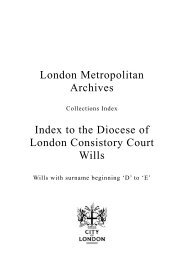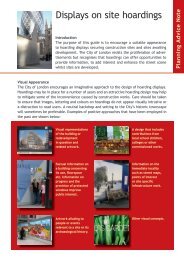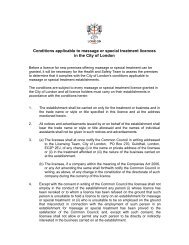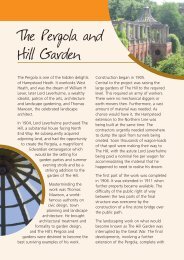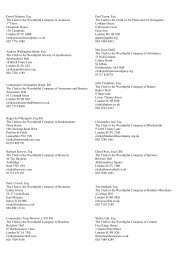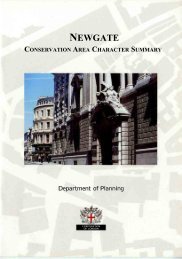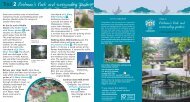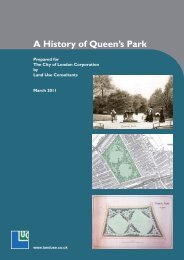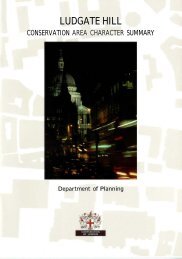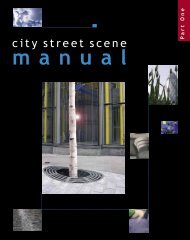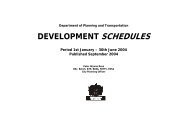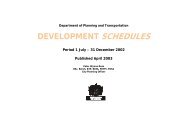Burnham Beeches Management Plan 2010 - the City of London ...
Burnham Beeches Management Plan 2010 - the City of London ...
Burnham Beeches Management Plan 2010 - the City of London ...
Create successful ePaper yourself
Turn your PDF publications into a flip-book with our unique Google optimized e-Paper software.
1.5.2 Archaeology<br />
1 Site Description - cultural heritage<br />
<strong>Burnham</strong> <strong>Beeches</strong> is considered to be ancient<br />
wood pasture with some ancient woodland<br />
within it, clearly bounded by wood banks dating<br />
from <strong>the</strong> 17th century. One earlier bank also<br />
crosses <strong>the</strong> reserve. In <strong>the</strong> woodland/wood<br />
pasture <strong>the</strong>re are abundant pits and hollows,<br />
most <strong>of</strong> which are <strong>the</strong> results <strong>of</strong> past quarrying<br />
activities. There are three Scheduled Ancient<br />
Monuments.<br />
Hartley Court moated site and enclosure is <strong>the</strong><br />
remnant <strong>of</strong> a medieval moated farmstead. It<br />
was probably built between 1250 and 1350 and<br />
<strong>the</strong> ditches and banks are easy to see, with <strong>the</strong><br />
moat holding water at least in <strong>the</strong> winter<br />
months.<br />
Seven Ways Plain univallate (having a single<br />
bank and ditch) hillfort is a series <strong>of</strong> earthworks<br />
dating between <strong>the</strong> Late Bronze age to Early Iron<br />
Age (8th-5th centuries BC). It may have been a<br />
permanent or temporary settlement; in more<br />
recent years has been damaged by quarrying<br />
and war time activities.<br />
East <strong>Burnham</strong> Animal Pound is on Crown Lane,<br />
not in <strong>the</strong> <strong>Beeches</strong> itself. It is a small rectangular<br />
red brick enclosure constructed between 1788<br />
and 1796 for <strong>the</strong> purpose <strong>of</strong> impounding<br />
unmarked cattle, sheep and swine found illegally<br />
grazing ‘<strong>the</strong> commons and waste grounds in <strong>the</strong><br />
manor’ (<strong>of</strong> East <strong>Burnham</strong>). This Grade II listed<br />
building has been repaired several times by <strong>the</strong><br />
<strong>City</strong> <strong>of</strong> <strong>London</strong>.<br />
1.5.3 Land Use History<br />
Until <strong>the</strong> 19th century <strong>the</strong> <strong>Beeches</strong> was <strong>of</strong> great<br />
importance locally as a source <strong>of</strong> wood and as<br />
grazing for livestock. Rough pasture with a high<br />
heathland component probably extended across<br />
almost <strong>the</strong> whole <strong>of</strong> <strong>Burnham</strong> <strong>Beeches</strong>. In <strong>the</strong><br />
north this was wood pasture with abundant<br />
pollarded beech and oak trees on it, to <strong>the</strong> south<br />
it was more open with only scattered bushes <strong>of</strong><br />
prickly shrubs such as juniper and holly. Across<br />
<strong>the</strong> whole area <strong>the</strong> number and density <strong>of</strong> trees<br />
probably varied greatly. In <strong>the</strong> 17th century two<br />
parcels <strong>of</strong> land were removed from <strong>the</strong> wood<br />
pasture and <strong>the</strong> trees within <strong>the</strong>m coppiced.<br />
The site was grazed with livestock until <strong>the</strong> 1930’s.<br />
By <strong>the</strong> time <strong>the</strong> <strong>City</strong> <strong>of</strong> <strong>London</strong> acquired <strong>Burnham</strong><br />
<strong>Beeches</strong> <strong>the</strong> need for <strong>the</strong> grazing and wood<br />
produced from <strong>Burnham</strong> <strong>Beeches</strong> had declined<br />
and <strong>the</strong> land use was changing. Recreation<br />
became much more important, with visitors<br />
largely from <strong>London</strong>. As <strong>the</strong> grazing declined,<br />
scrub grew up and <strong>the</strong> open aspect and easy<br />
access throughout <strong>the</strong> site was slowly lost.<br />
During <strong>the</strong> Second World War <strong>the</strong> site was<br />
cordoned <strong>of</strong>f and most was used as Vehicle<br />
Reserve Depot No. 2. Prior to <strong>the</strong> D-Day<br />
landings an estimated 10,000 vehicles were<br />
stored within <strong>the</strong> <strong>Beeches</strong> at any one time; <strong>the</strong><br />
men lived at a camp built on Seven Ways Plain.<br />
Since <strong>the</strong> War <strong>the</strong> <strong>Beeches</strong> has once again<br />
become an important area for recreation and<br />
it is now also managed for its high nature<br />
conservation value.<br />
9



